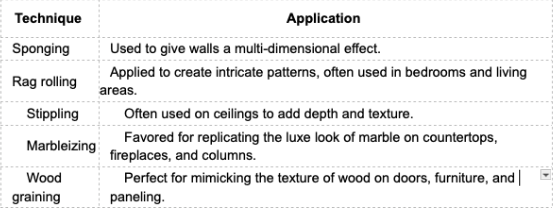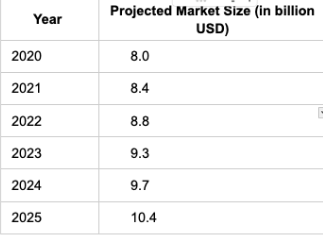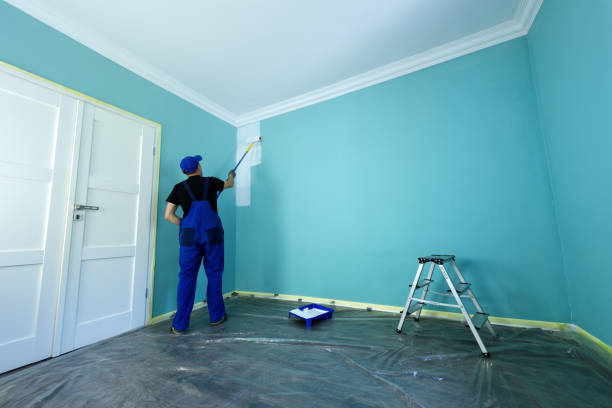The art of decorative painting has evolved over centuries, offering a plethora of design possibilities for enhancing the aesthetic appeal of spaces. Faux finishes, a prominent technique within this realm, mimic the appearance of materials such as marble, wood, and stone to create luxurious interiors without the associated costs. With the perfect blend of creativity and craftsmanship, faux finishes offer an economical way to elevate home decor.
This article delves into the intricate world of faux finishes, providing insights on techniques, benefits, industry challenges, and future trends.
The History and Evolution of Faux Finishes
The use of faux finishes traces back to ancient times in Egypt, where artisans employed techniques like sponging and ragging to replicate the appearance of expensive materials. Throughout history, the use of these techniques has evolved, with the Renaissance period being a particularly important era in the development of faux finishes.
As faux finishes moved across Europe and made their way to the United States, they began to be utilized in various ways to transform spaces into luxurious sanctuaries.
Key Features
The myriad advantages of faux finishes have significantly contributed to their popularity. Here are a few key reasons why designers globally opt for faux finishes:
- Sustainability: They offer an eco-friendly alternative to natural resources, thus contributing to sustainability.
- Affordability: Faux finishes provide the opulence of high-end materials without the steep price tag associated with real material.
- Versatility: A multitude of textures can be created with different faux finishing techniques, offering impressive design flexibility.
- Durability: These finishes are not only aesthetically pleasing but also highly durable and long-lasting.
Faux Finishing Techniques and Their Common Applications

Benefits of Using Faux Finishes
Adopting faux finishes in your home or office interior design has a multitude of benefits that are often overlooked. Not only do these finishes offer a visually appealing alternative to natural materials, but they also present practical and environmental advantages.
Economical
First and foremost, the use of faux finishes is a cost-effective design choice. Genuine materials like marble, wood or stone can be prohibitively expensive and often require professional installation and maintenance. In contrast, faux finishes can replicate the luxury and opulence provided by these natural materials at just a fraction of the price. This allows homeowners and designers alike to achieve their desired aesthetic without breaking the bank.
Environmentally Friendly
Beyond the cost benefits, faux finishes also offer a more sustainable choice in interior design. By opting for faux finishes, the need for quarrying stone and deforesting for wood drastically decreases. This reduction in resource extraction contributes to the preservation of our environment, making faux finishes an eco-friendly alternative to real materials.
This consideration is particularly important, given the increasing consumer preference towards sustainable options. A report by the prestigious Harvard Business Review indicates that a whopping 65% of consumers are leaning towards environmentally friendly choices in their purchasing decisions.1
- Reduction in quarrying and deforestation
- Less energy used in manufacturing process compared to real materials
- Decrease in harmful emissions involved in the procurement of natural materials
Durability and Maintenance
Another key benefit of using faux finishes is their durability and low maintenance requirements. Unlike natural materials, faux finishes are designed to withstand wear and tear, resisting scratches, scuffs, and stains, significantly extending the lifespan of the finished surfaces. Furthermore, their cleaning process is typically straightforward, often requiring nothing more than a simple wipe down.
Material | Average Lifespan | Maintenance Requirement |
Faux Finish | 15 years | Low |
Wood | 10 years | High |
Marble | 20 years | Moderate to High |
Stone | 20 years | High |
The Role of Professional Artisans
The art of faux finishing requires a high degree of skill, artistry, and experience. These traits are embodied by professional artisans, who through their expertise and years of training bring significant value to the table. They use their knowledge in blending colors accurately, applying diverse techniques meticulously, and crafting unique designs that align perfectly with the individual tastes and visions of clients.
Professional artisans not only add aesthetic value but also provide practical solutions. Their work regulates temperature, improves durability, and enhances the longevity of surfaces, thereby increasing the overall performance of spaces.
- As per Insidesources.com, interior design enhancements like faux finishes can add up to a 12% increase in home value.
- About 70% of home-buyers would consider paying more for homes with high-quality finishes, according to a survey by National Association of Realtors.
The escalating demand for skilled faux finishers has led to the growth of specialized training programs in this field, ensuring the ongoing knowledge transfer and that quality craftsmanship remains a priority in the industry. Many renowned institutions, such as The Faux Finish School and the Institute of Decorative Painting, have produced many skilled artisans over the years.
Challenges in the Decorative Painting Industry
Despite its many benefits, the decorative painting industry is not without obstacles. The availability and convenience of budget-friendly alternatives such as wallpapers, digital prints, and cheap DIY paint kits have increased competition for professional artisans. Furthermore, the quality of craftsmanship greatly varies, impacting client satisfaction and making the establishment and maintenance of stringent industry standards crucial.
The U.S. Bureau of Labor Statistics projects a slow growth rate of approximately 5% from 2020 to 2030 for painters in various sectors. This slow growth indicates potential concerns for sustained industry expansion and might lead to the saturation of career opportunities in the industry.
Industry Statistics
- The painting and wallpaper installing industry contributed about $12 billion to the U.S economy in 2019, according to IBISWorld.
- Currently, there are approximately 270,000 businesses in the decorative painting industry in the United States (Statista).
Key Challenges in the Decorative Painting Industry
Challenge | Impact |
Competition from Alternatives | Increased choices for consumers leading to a divided market share. |
Craftsmanship Variability | Potential decrease in client satisfaction, leading to a tarnished industry reputation. |
Limited Industry Growth | Slower rise in employment opportunities, leading to a saturated jobs market. |
Trends in Faux Finishes and Decorative Painting
Trends in faux finishes continue to evolve, supported by the integration of modern designs that combine elements of contemporary art and high-end technology. Signature trends such as metallic hues, geometric patterns and the use of digital stenciling methods are reshaping the industry landscape.
These innovative approaches are notably catering to a diverse client base that seeks personalized and distinctive looks, thereby challenging leading-edge companies like Evercrest Painting, a pioneer in decorative painting services, to consistently come up with cutting-edge design solutions.
Popular Trends in Faux Finished
The continuous evolution of faux finishes and decorative painting has given rise to several emerging trends. These include:
- Metallic Finishes: Metallic finishes, offering a glossy and elegant appearance, are becoming a preferred choice for many homeowners and interior designers. They add a touch of luxury to any space.
- Geometric Patterns: Geometric patterns provide a modern, sophisticated look. They can be used to create a striking focal point or add a dash of style to a minimalist design.
- Digital Stenciling: Easier to apply and offering a massive range of precision-cut designs, digital stenciling is steadily gaining popularity. It allows for more customization and adds unique character to homes.
The Future of Faux Finishes
As we look forward, the future of faux finishes and decorative painting is poised for further innovation. The industry’s adaptability to emerging technologies, coupled with the increasing demand for eco-friendly, cost-effective solutions, signals its continued vitality.
Projections indicate a surge in the residential sector, where consumers place a higher emphasis on aesthetics amalgamated with sustainability, thus fueling further market expansion.
Projected Market Growth (2020-2025)

Conclusion
Faux finishes provide a unique opportunity to infuse luxury and style into any space without the high costs associated with natural materials. The industry remains dynamic, driven by innovation, sustainability trends, and the creative visions of expert artisans. While challenges do exist, particularly regarding competition and market growth, the demand for customized decorative painting solutions suggests a bright future for faux finishes.
Engaging professional services like Evercrest Painting ensures high-quality craftsmanship, transforming spaces into artful expressions of beauty and elegance.
Related blog topics you may be interested in:
A Fresh, Modern Update: The Power of a Cohesive Interior Repaint
The Importance of Professional Commercial Interior Painting for Colorado Springs Businesses
Christmas in July? 7 Times of Year You Never Thought to Book a Painting Project (But Should)
When is the Right Time to Paint My Home Interior
Top Color Trends for Commercial Interiors in Colorado Springs
FAQs on Faux Finishes and Decorative Painting
What are faux finishes used for?
Faux finishes are used in decorative painting to create surfaces that mimic the appearance of other materials, like wood, marble, or stone. They are utilized in both residential and commercial spaces to add texture, depth, and visual interest to walls, ceilings, and furniture. These finishes provide a cost-effective alternative to expensive materials, offering diverse design possibilities without the complexities of natural installations.
How can I apply faux finishes myself?
Applying faux finishes yourself involves a blend of preparation, technique, and practice. Begin by choosing the right materials and prepping the surface by cleaning, sanding, and priming it. Once prepared, select a technique that suits your desired look, such as sponging, ragging, or stippling. Use appropriate tools like brushes, rollers, or sponges to apply layers of paint, gradually building up the texture. For beginners, it’s crucial to start with simpler patterns before moving onto more complex designs.
What is the cost of professional faux finishing?
The cost of professional faux finishing varies widely depending on factors like the complexity of the design, size of the area to be covered, and geographic location. Typically, professional services might charge by the square foot, with prices ranging from $2 to $30 per square foot or more. High-end and intricate designs are on the pricier end of the spectrum.
Why hire a professional for decorative painting?
Hiring a professional for decorative painting ensures a flawless execution of complex faux finishes. Professionals possess the necessary skills, experience, and artistic flair to blend colors, textures, and patterns seamlessly. This expertise guarantees a polished look that aligns with design visions. Moreover, professionals have access to high-quality materials and tools, ensuring durability and precision in their work.
Are faux finishes considered environmentally friendly?
Faux finishes are increasingly considered environmentally friendly, largely due to their ability to create luxurious effects without depleting natural resources. By mimicking materials like marble or wood, faux finishes reduce the demand for quarrying and deforestation. Additionally, many professionals now use low-VOC (Volatile Organic Compounds) paints and pigments, which contribute less to air pollution and are safer for indoor environments.

